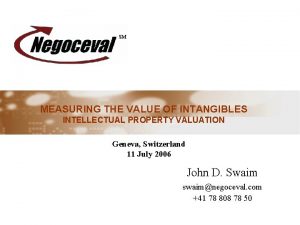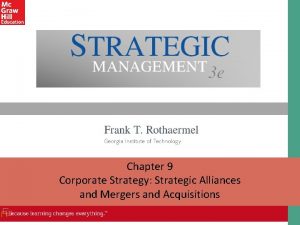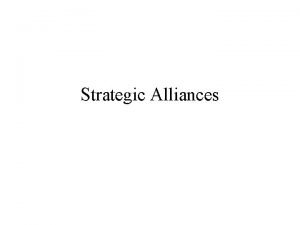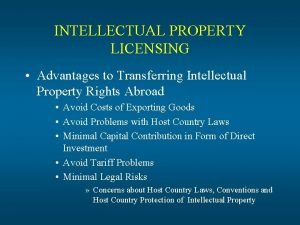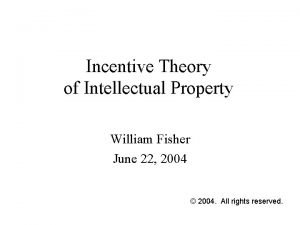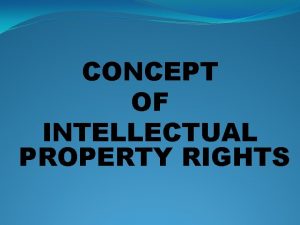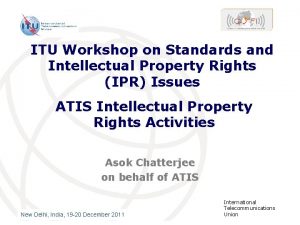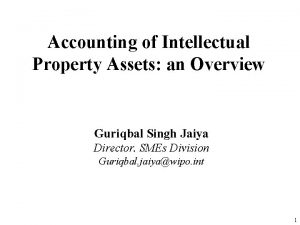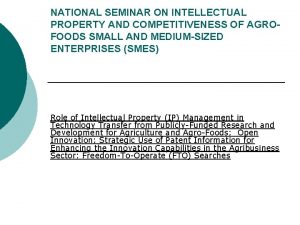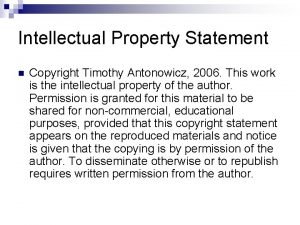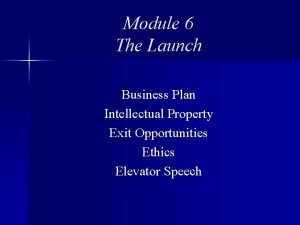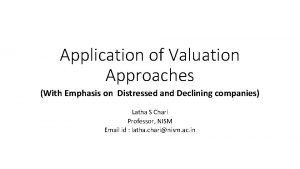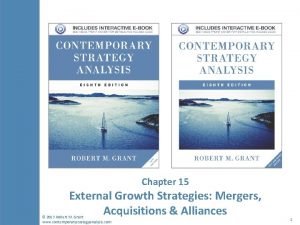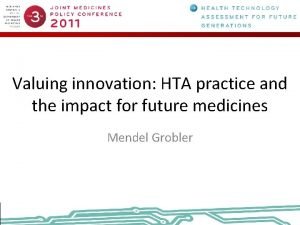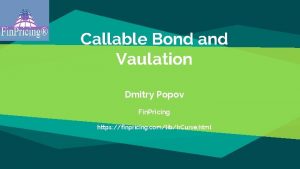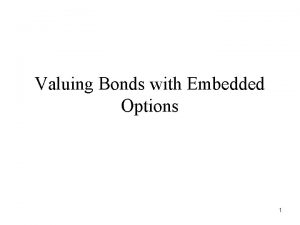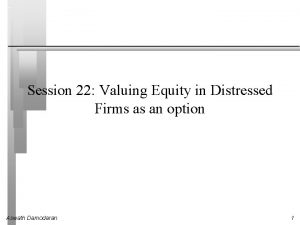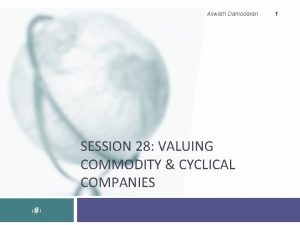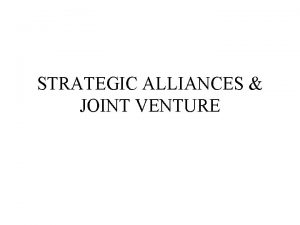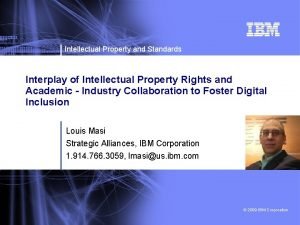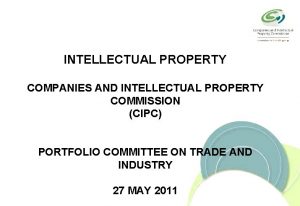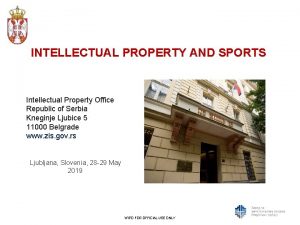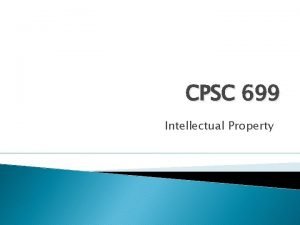Valuing Your Intellectual Property for Strategic Alliances and











































- Slides: 43

Valuing Your Intellectual Property for Strategic Alliances and Financing NJSBDC Presentation December 8, 2004 David G. Weiler Executive Vice President AUS Consultants, Inc.

Intellectual Property (IP) n n n n Patents Trademarks Copyrights Technological Know-How Designs Formulae Trade Secrets

Factors Driving IP Value n Time Savings (know how) n Cost Savings (formula) n Risk n Profits Advantage (patent)

Intellectual Property Profit Sources n n n Premium Sales Price Cost Savings Volume Synergy

IP Requires Old Economy Assets IP commercialization and the realization of value is not possible without complementary assets.

Business Enterprise Value Equity Value + LTD = Invested Capital This equation also equals Working Capital + Fixed Assets + Intangible Assets + Intellectual Property

Working Capital n Cash n Inventories n Accounts Receivable

Fixed Assets n n n n Machinery & Equipment Real Estate Factories Warehouses Trucks Office Furniture & Equipment Computers

Intangible Assets n n n n Distribution Networks Supply Contracts Customer Lists Manufacturing Practices Trained Work Force Administrative Procedures Computer Systems Satisfying Regulations

Intellectual Property n n n n Patents Trademarks Copyrights Technological Know-How Designs Formulae Trade Secrets

Why is IP Really Valuable? n n n Anyone can capacity Anyone can buy real estate build manufacturing borrow money hire an Ad Agency hire skilled labor ONLY IP PROVIDES A UNIQUE AND PROPRIETARY ADVANTAGE.

IP & IA is Over 80% of Corporate Value Not Just High Tech Companies n n n Heinz – food Procter & Gamble – household products 3 M – industrial products Philip Morris – tobacco Loctite – adhesives Microsoft – software

Intellectual Property Valuation Methods Three Traditional Valuation Methods Adapted for Intellectual Property

Valuation Methods n COST APPROACH n MARKET APPROACH n INCOME APPROACH

Cost Is Not Value Millions were spent by RJR on developing a smokeless cigarette. Millions were spent on nuclear powered aircraft engines. Millions were spent on synthetic leather by Du. Pont.

Cost Approach Limitations Used for intangible assets and embryonic technology where market potential exists but is impossible to estimate at the early stage.

Market Approach Comparison of subject intellectual property to recently transferred property that is similar and for which price information is available.

Ideal Market Approach Comparison n n Transaction should be between unrelated parties. Relevant date of transaction. Neither party compelled to complete the transaction. Involve similar intellectual property for use in the same industry in which the fair market value is desired.

Market Transactions Are Rare n n n Sale of the Black Hawk meat packer trademark in 1985 for $3 million. Sale of the Gloria Vanderbilt trademark by Murjani in 1988 for $15 million. Purchase of thirty-two medical remedy trademarks by Menley & James Laboratories for $52 million.

Market Approach Difficulties n n Few Transactions of Similar Property Financial Details Often Not Disclosed

Income Approach Present Value of Future Economic Benefits Income Value = -----Rate

Future Economic Benefits n n n What future sales do you expect? How long will it be profitable to use the asset? What profits do you expect? What capital investment is required? What rate of return will you earn?

Direct Economic Benefit Examples n n n Reduction in the amount of raw material input that is required per unit of output. Reduction in the amount of electrical, gas, or steam energy used in the manufacturing process. Automation of part or all of the process, thus allowing a reduction in the amount of labor.

Income Approach n Allocation of Earnings n Royalty Approach

Income Approach Allocate Earnings Total Earnings Working Capital Intangible Assets Fixed Assets Intellectual Property

Income Approach Allocate Earnings Total Earnings Less Return on: Working Capital Fixed Assets Intangible Assets Equals: Intellectual Property Return

Income Approach Driving the Allocation of Earnings n n Value of assets relative to the entire business enterprise. Investment risk associated with the different assets.

Present Value Calculation Allocated Earnings

Discount Rate is Powerful n n A higher discount rate indicates more risk. More risk translates into lower value.

PV @ Different Discount Rates

Relative Risk and Return n n Risk-Free Rate Mature Product Pre-National Launch Technology only is sure Embryonic R&D 1 Think like a venture capitalist. 3% 10% 15% 25% 50%1

Technological Risks n n Failure to make transition from laboratory to large scale manufacturing. Failure to be cost effective to manufacture. Stronger and newer competitive technology. Undesirable side-effects Industry). (drug

Consumer Acceptance Risk n n n Not compatible with current infrastructure High cost for customers to switch (even when new product is superior) General Reluctance of Consumers to Change

Income Approach Royalty Approach Present Value of Future Royalty Payments n n n Forecast Licensee Revenue Select Royalty Rate Select Discount Rate

Royalty Rate Rules-of-Thumb n n 25% of Operating Profit Industry “Norms” Return on R&D Costs 5% Standard DANGER

Royalty Rates and Profit Differential Analysis Enhanced Product Profit Margin less Commodity Product Profit Margin equals ROYALTY RATE

Royalty Rates and Profit Differential Analysis Operating Profit Margins: Standard Medical Instrument 10% Patented Instrument 20% Differential 10%

Royalty Rates and the Market Approach Look at the royalties negotiated between independent parties for the exchange in a license agreement of similar property.

Royalty Rates and the Market Approach Sources of Royalty Rates n n n n Royalty. Source. com IPresearch. com Consor – La Jolla, California Big Accounting Firms Existing in-house licenses Infringement lawsuit awards Royalt. Stat

Royalty Rate Data for Technology

Royalty Rate Data for Technology Source: Dan Mc. Gavock of IPC Group, Chicago Based on survey results

Royalty. Source® Transaction Analysis Industry Average Median Chemicals Internet (incl software) Telecom (excl Media) Consumer Gds, Rtl & Leis Media & Entertainment Food Processing Medical/Health Products Pharma & Biotech Energy & Environment Machines/Tools Automotive Electrical & Electronics Semiconductors Computers & Office Equip Software 4. 7% 11. 8% 4. 9% 5. 5% 9. 1% 3. 2% 6. 1% 7. 0% 5. 2% 4. 3% 4. 2% 4. 3% 5. 3% 11. 5% 4. 3% 8. 8% 4. 5% 5. 0% 2. 8% 5. 0% 4. 5% 3. 5% 4. 0% 3. 0% 4. 0% 6. 8% Industry Summary 6. 40% 4. 80% Max Min 25. 0% 50. 0% 15. 5% 28. 0% 50. 0% 10. 0% 77. 0% 50. 0% 25. 0% 15. 0% 30. 0% 25. 0% 70. 0% 0. 1% 0. 3% 0. 4% 0. 1% 2. 0% 0. 3% 0. 1% 0. 0% 1. 0% 0. 5% 0. 0% 0. 2% 0. 0% Count 78 88 73 98 25 38 376 458 107 90 59 139 75 73 147 1, 924

Present Value Calculation Royalty Approach
 Valuation of ip
Valuation of ip Entry strategy and strategic alliances
Entry strategy and strategic alliances Build borrow buy framework
Build borrow buy framework Entry strategy and strategic alliances
Entry strategy and strategic alliances Entry strategy and strategic alliances
Entry strategy and strategic alliances Global strategic alliance definition
Global strategic alliance definition Trade-related aspects of intellectual property rights
Trade-related aspects of intellectual property rights Intellectual property rights in professional practices
Intellectual property rights in professional practices Importance of intellectual property
Importance of intellectual property Intellectual property management definition
Intellectual property management definition Advantages of intellectual property
Advantages of intellectual property Intellectual property business plan example
Intellectual property business plan example Property
Property Right to intellectual property of teachers
Right to intellectual property of teachers Definition of ipr
Definition of ipr Incentive theory
Incentive theory Concept of intellectual property
Concept of intellectual property Intellectual property rights
Intellectual property rights Intellectual property rights
Intellectual property rights Characteristics of intellectual property
Characteristics of intellectual property Discuss intellectual property frankly
Discuss intellectual property frankly Intangible inputs
Intangible inputs Intellectual property
Intellectual property Intellectual property statement
Intellectual property statement Intellectual property business plan example
Intellectual property business plan example Evalueserve intellectual property
Evalueserve intellectual property Discuss intellectual property frankly
Discuss intellectual property frankly At&t ecommerce
At&t ecommerce Valuing distressed and declining companies
Valuing distressed and declining companies Alliances and acquisitions
Alliances and acquisitions Valuation of private companies
Valuation of private companies Affective verbs for objectives
Affective verbs for objectives Psychomotor objectives examples
Psychomotor objectives examples Behavior domain
Behavior domain Triumvirate rome
Triumvirate rome Valuing oral language quotes
Valuing oral language quotes Valuing innovation
Valuing innovation Valuing time in professional ethics
Valuing time in professional ethics Vaulation
Vaulation Bonds with embedded options
Bonds with embedded options Valuing distressed companies
Valuing distressed companies Valuing culture
Valuing culture Valuing land for social housing
Valuing land for social housing Valuing commodity companies
Valuing commodity companies
